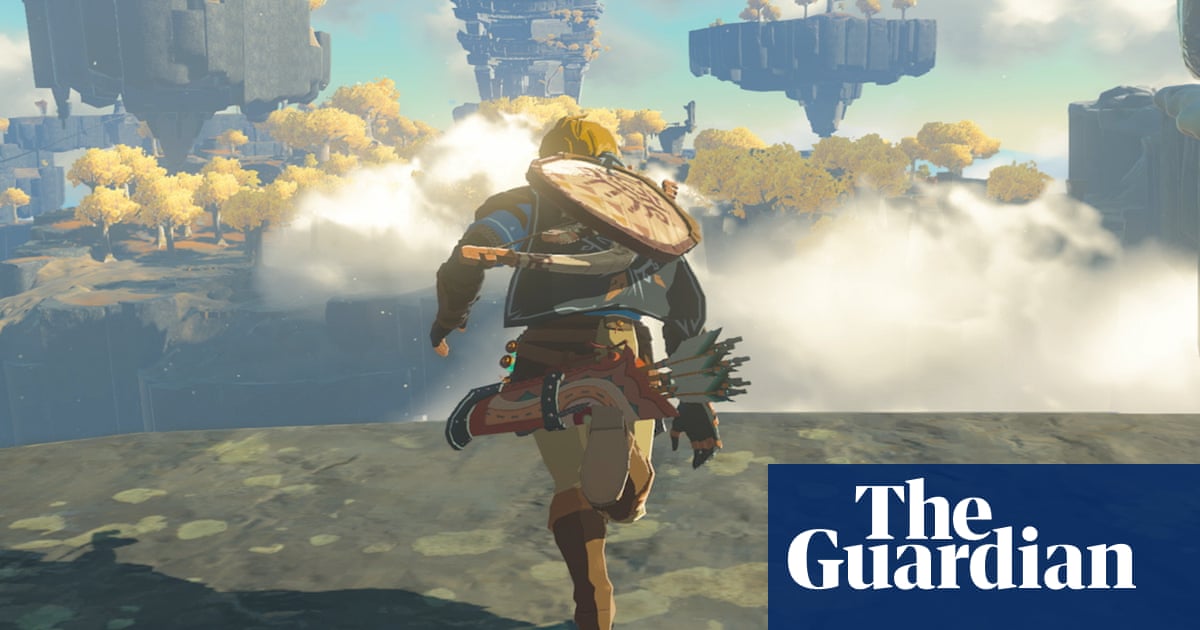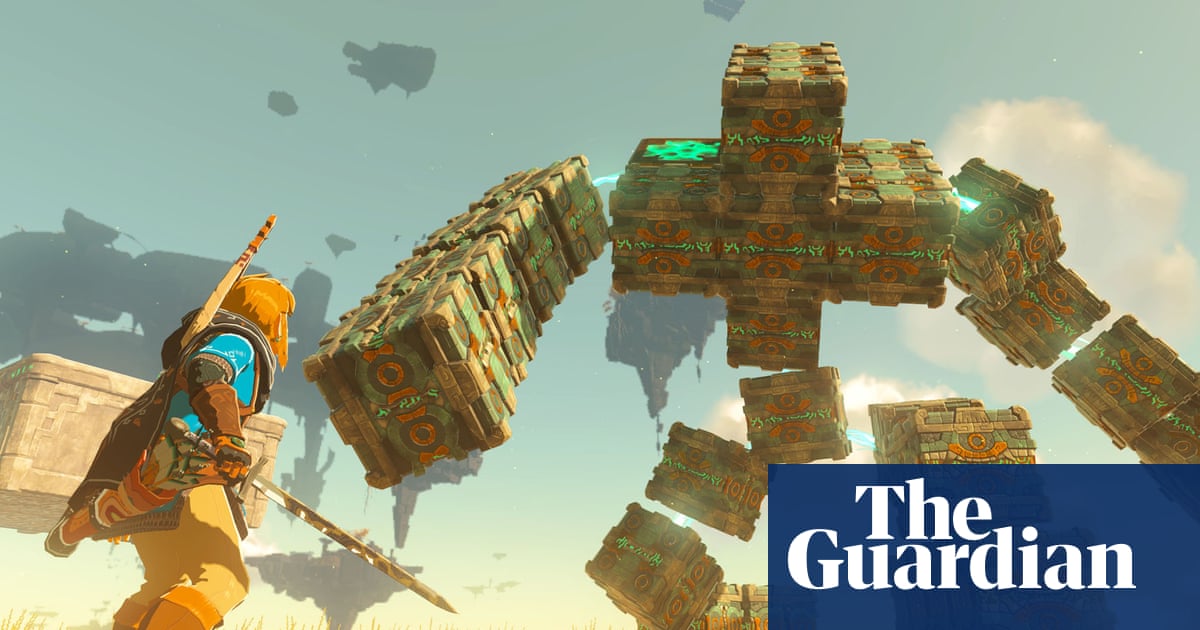
The release of a new Zelda game is always a major event worldwide. Ever since 1986, when famed Japanese game designer Shigeru Miyamoto first attempted to capture in code some of the wonder he experienced exploring the Kyoto countryside as a child, Zelda games have been pushing the boundaries of what’s possible in virtual worlds. Look at any best-games-of-all-time list and you’ll see Zelda in the Top 10, often more than once.
But 2017’s The Legend of Zelda: Breath of the Wild was particularly special. Launching alongside the Nintendo Switch console, which has since sold more than 125m units, it was perhaps the best realisation yet of the promise of boundless freedom and adventure that video games have been dangling in front of players’ noses for decades. It got rave reviews and sales hit 30m, many millions of those buyers new to the fantasy world of Hyrule. Pretty much everyone loved it. Soon, indie-pop star St Vincent was confessing to putting 300 hours into it.
So what do you do after you’ve just released one of the best video games ever? For director Hidemaro Fujibayashi and the rest of Breath’s team, the answer was simple: try to make something even better. Remarkably, they now appear to have managed it. The sequel, Tears of the Kingdom, was released on Friday and had critics (including me) displaying an unbecoming lack of restraint. Set in the same world as Breath, it expands the game upwards to gorgeous sky islands, and downwards through gaping chasms to Hyrule’s dark and dangerous underworld, letting players move freely between them. The ultimate aim, as it always has been, is to track down Princess Zelda and save the realm from an encroaching evil, but how you get there is up to you. Tears of the Kingdom asks that you approach its puzzles and environments even more creatively, smooshing together self-made weapons and contraptions from parts left lying around. It is a technological and creative marvel.
Fujibayashi tells me that the idea for Tears coalesced, appropriately, through experimental play – the same kind of messing around that Breath’s players have been doing in thousands of hours of YouTube videos over the past six years. Almost immediately after Breath’s release, the team started tinkering, to see if they could get more out of the world they had created. “There were various objects you could ride around on or move around, such as gears that turned on their own,” he explains. “We tried attaching those to a board – and realised you could make a car. Another thing you could do was use four boards to create a tube, then use a remote-control bomb to turn it into a cannon and make objects fly. Boards stuck to gears could create paddles to power a boat. We thought there was a lot of potential just using what was already there.”
After a few months of figuring out exactly what he wanted to make, Fujibayashi put together a video showing off the team’s ambitions, to present to his bosses at Nintendo. Among them were Miyamoto, now 70 and still a strong presence at the company, along with producer Eiji Aonuma, from whom Fujibayashi took the reins of Zelda in 2011. Aonuma is the most recognisable face of Zelda, director of some of the series’ greatest hits, from 1998’s stunningly innovative and atmospheric Ocarina of Time, to 2003’s cartoonish sailing adventure Wind Waker. He also directed my personal favourite: 2000’s Majora’s Mask, an eerie tale of impending disaster and lost innocence.
Aonuma is an amiable presence, with a laugh full of the playful glee his games often inspire. He has worked on Zelda since the mid-90s – nobody understands the series better. Yet, he admits, at first he wasn’t entirely sold on Fujibayashi’s ideas. “It was my suggestion to make the next game a sequel,” says Aonuma. “I thought there was still a lot we could do with this world. But I can’t see so much into the future, so initially I was like, ‘Is this really going to work?’”
Fujibayashi’s blueprints got the green light regardless and, as work progressed, Aonuma was slowly won over. In Nintendo’s Kyoto HQ, the two work on either side of a partition, and Aonuma is given to involuntary yelps when he’s enjoying a game. “Depending on how much I voice my excitement, I can gauge whether something’s really fun,” he says with a laugh. Fujibayashi smiles and remembers his colleague test-driving his new creations: “I’d hear him going, ‘Gaaahh, how do I do this? What? I can’t – oh wait, I did it!’ When those shouts kept coming, I knew this was going to be a good game.”
It shouldn’t be a surprise that Tears tries something radical. In three decades, Zelda has never shied away from reinventing itself. Like all the best legends, it is reshaped with each fresh incarnation. But some elements endure. Across 20 or so games, there’s always an elven hero named Link fighting a great evil. He, Princess Zelda and demon-king Ganondorf appear again and again, in different forms and timelines, in different versions of a kingdom named Hyrule that might be flooded, fractured, war-torn or long abandoned.
The Link of Ocarina of Time and Majora’s Mask is a rather tragic figure: a kid sent forward in time to save the world, and robbed of his own childhood in the process. In Wind Waker, he is a boisterous youngster, rendered in bold cartoon lines. In Twilight Princess, he is a teen hero for the emo age, silent and sullen. The stories of all the Zelda games fit together in a branching timeline, but each can also stand alone as a version of the myth.
Breath was a turning point, simply because of its peerless sense of freedom. Before, Zelda games were made up of overworlds and dungeons: you’d explore them in sequence, each dungeon bestowing a new tool that opened up more of the map. The puzzles were locks with specific keys: throw boomerangs at switches, use bombs to blow up cracked walls, pull yourself across chasms with a hookshot. In both Breath and Tears, though, you can go anywhere, following your own sense of adventure. You’ll never find yourself unable to explore further because you don’t have the right gadget: instead, the limitation is your own imagination, or your own ingenuity.
A Link Between Worlds, the Nintendo 3Ds game from 2013, felt like a bridge between the structure of classic Zelda and the total openness of modern Zelda; playing it now, you can see Aonuma and the team straining against old conventions. But, he says, it was the technological advance of the Nintendo Switch console that finally freed them: “In the past, there always had to be an entrance and an exit.” This was down to older consoles’ memory limits. “That’s why we needed dungeons. But now these things can all be connected. The freedom has been made possible by the evolution of the hardware. Having a seamless experience greatly improves the game design as well.”
For all that Zelda has changed, and for all that Tears brings to the table, some things stay the same. As a child, when I first played Zelda: A Link to the Past, it was the only game world I’d ever encountered that felt as rich and full of promise as the fantasy novels I loved – and the games still retain that depth and mystery. They feel like you could live inside them. And they’re still games about curiosity, tapping into the human impulse to explore. Every time you solve one of its puzzles, you get a tremendous feeling of accomplishment.
“A lot of the time,” says Aonuma, “people tell me Zelda gives them these wonderful ‘I did it!’ moments – when they solve a puzzle and think they must be the only person in the world who could have cracked it. If we provided too much guidance about how to do things, they wouldn’t feel that way. The satisfaction comes from exploring and figuring things out – that’s the route to joy. In Tears of the Kingdom, I believe this feeling has become even stronger.”
“Zelda,” adds Fujibayashi, “allows us to make games based on plenty of ideas. I can always realise whatever it is that I want to achieve. I approach each new idea, each new game, with excitement. Even though I’ve been working on the Zelda series for a long time, I’ve never gotten bored.”
The Legend of Zelda: Tears of the Kingdom is out now on Nintendo Switch; £59.99








